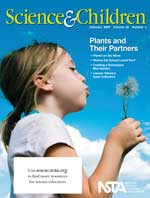Planting peas—who will help students record the growth?
By Peggy Ashbrook
Posted on 2009-02-07
I’m wondering what crops your class grows—Peas? Collards? Cilantro? Zinnias? Marigolds?
 Planting peas on President’s Day has been the first item on my planting list for many years, and is the topic of the Early Years column in the February 2009 issue of Science and Children.
Planting peas on President’s Day has been the first item on my planting list for many years, and is the topic of the Early Years column in the February 2009 issue of Science and Children.
In USDA Plant Hardiness temperature zone 7a (see map), February is the earliest time I can plant this cool-weather crop. But this year with temperatures varying from 21°F to 51°F in the same week, I’m never sure if the children will be able to plant on days that I’m at their school. Results have been mixed. One year we had enough pea pods for every child to try one. They loved the crunch! Another year every pea shoot was eaten to a stub, perhaps by voles? Then there was the year there was so little rain and not enough human water-ers that the pea plants were stunted and produced only a few pods.
One of the joys for teachers who have one class is being able to develop a close relationship, and to be there for all the teachable moments. As a “push-in” science teacher, I’m not in the class the next day so I can’t immediately follow up on the spider that was found behind the blocks, or assist the children’s daily observations of a pea seed sprouting in a bag. (But I do get to fine-tune my teaching by trying it out on many classrooms with different populations and different curriculums.) The Fall 2008 issue of The Science Educator (Volume 17, Issue 2) discusses how the Center for Science Education at Education Development Center, Inc. invited researchers and practitioners to come together to think about the best models for teaching science in elementary schools—by the classroom teacher, by a science specialist, or a mixture of those arrangements. As scientists do, they first talked to define their terms, to better communicate with each other. This research is exciting because whenever education researchers mix it up there will be new information for teachers to use in the classrooms as we work towards using the best practices.
One way to share the results of seed sprouting is to have a brief class observation and drawing time every day. Date the drawings and encourage students to write or dictate their descriptions. Posting the drawings outside the classroom lets others follow the progress of your class’s discoveries.
Peggy
Disclaimer: The views expressed in this blog post are those of the author(s) and do not necessarily reflect the official position of the National Science Teaching Association (NSTA).


